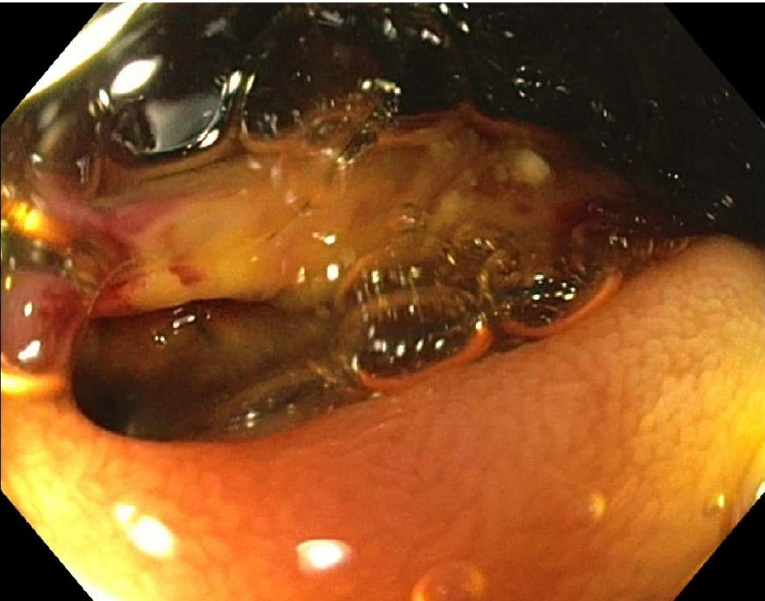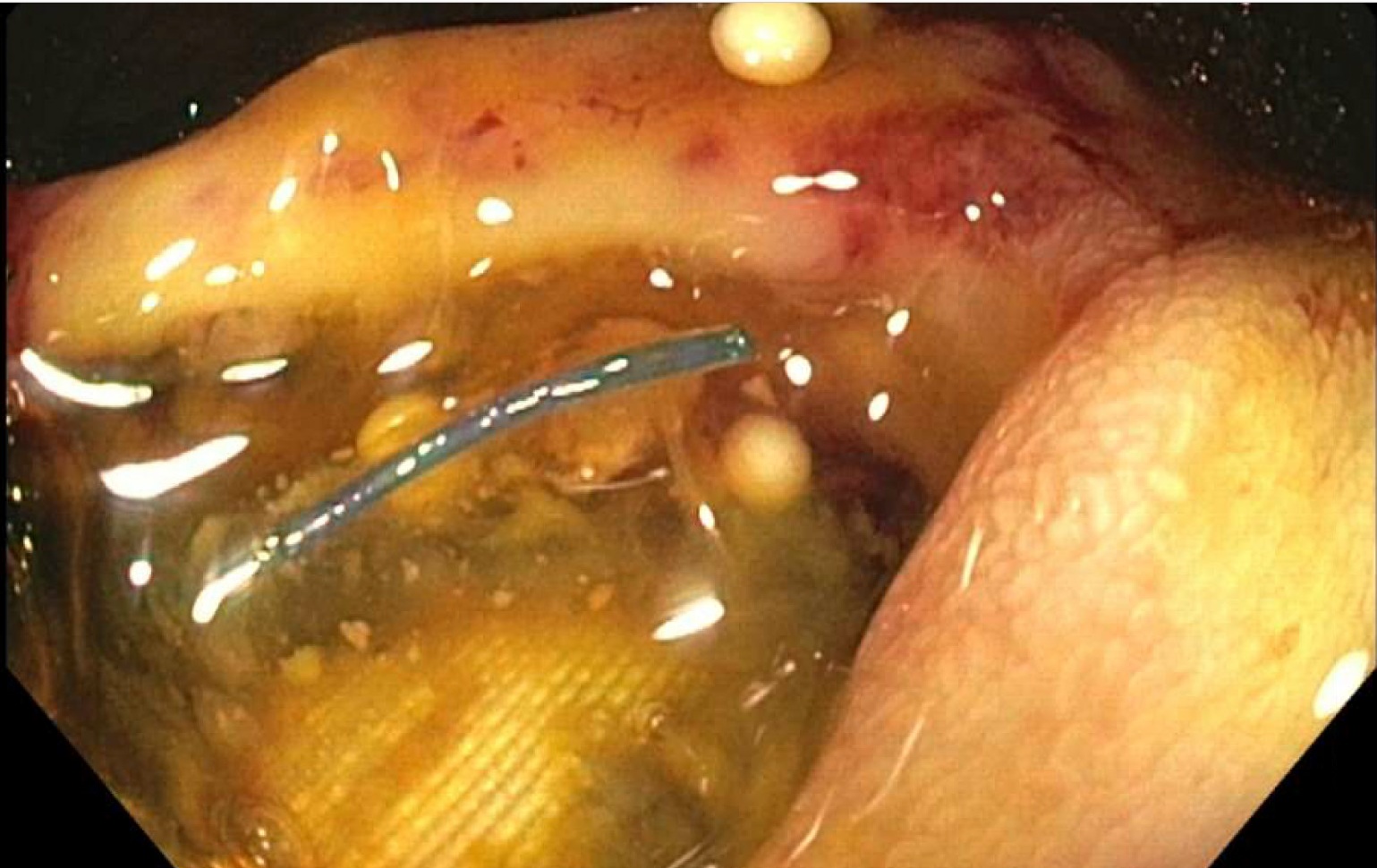Monday Poster Session
Category: General Endoscopy
P3021 - Occult Aortic-Duodenal Fistula Found in Endoscopy
Monday, October 27, 2025
10:30 AM - 4:00 PM PDT
Location: Exhibit Hall

Fariba Hossain, BS (she/her/hers)
University of Arizona College of Medicine
Tucson, AZ
Presenting Author(s)
Fariba Hossain, BS, Celeste R. Gracey, DO, Cameron Thompson, MD
University of Arizona College of Medicine, Tucson, AZ
Introduction: Aortoenteric fistulas (AEFs) are a rare and destructive surgical complication that can present with both acute gastrointestinal bleed and infection with gastrointestinal flora. These typically occur when a synthetic aortic graft breaks down the surrounding enteric system. We present a rare case of an AEF identified in endoscopy that did not present with gastrointestinal bleed or bacteremia.
Case Description/
Methods: A 63-year-old male had a past medical history of coronary artery stents, tobacco use, peripheral arterial disease, and aortobifemoral bypass with subsequent thrombosis and stenting 8 years prior. He presented following a syncopal fall while on apixaban. The week prior, he had been complaining of lower abdominal and back pain. He denied any signs of bleeding or melena. He was afebrile and his abdomen was soft, mildly distended, and tender. Initial labs were significant for a hemoglobin of 7.3 g/dL (11.4 g/dL one month prior), white blood cell count of 19.6 K/uL, and lactic acid of 4.9 mmol/L. A computed tomography scan was concerning for a ruptured infrarenal aortic aneurysm including para-aortic and left perirenal hematomas. He was emergently taken for endovascular repair. Gastroenterology was consulted because his end-to-side aortobifemoral bypass and additional stenting put him at a greater risk for an AEF. There was also concern that an occult infection associated with the hematomas. An esophagogastroduodenoscopy (EGD) visualized stent material in the third portion of the duodenum without any sign of bleeding or infection. The endoscopist tattooed the fistula site distally and proximally. Following the EGD, the patient developed increased abdominal distention and tachycardia. Imaging was concerning for a large pneumoperitoneum, which at the time was felt to be secondary to the fistula leaking during insufflation. The patient underwent a second emergency surgery, where it was discovered that he had suffered a perforated cecum with feculent peritonitis. Unfortunately, during graft explantation, the patient suffered a massive bleed and subsequent death.
Discussion: AEFs are a rare complication of aortic surgery. Cases typically present with gastrointestinal symptoms, however we present a case where the patient had a visible stent material in his duodenum without signs of gastrointestinal bleeding or infection. In cases where there is concern for AEF with or without typical gastrointestinal symptoms, endoscopy can be helpful for evaluating a patient’s surgical needs.

Figure: Graft and stent material seen through an aortoenteric fistula during endoscopy.

Figure: An aortoenteric identified in the fourth portion of the duodenum during endoscopy.
Disclosures:
Fariba Hossain indicated no relevant financial relationships.
Celeste Gracey indicated no relevant financial relationships.
Cameron Thompson indicated no relevant financial relationships.
Fariba Hossain, BS, Celeste R. Gracey, DO, Cameron Thompson, MD. P3021 - Occult Aortic-Duodenal Fistula Found in Endoscopy, ACG 2025 Annual Scientific Meeting Abstracts. Phoenix, AZ: American College of Gastroenterology.
University of Arizona College of Medicine, Tucson, AZ
Introduction: Aortoenteric fistulas (AEFs) are a rare and destructive surgical complication that can present with both acute gastrointestinal bleed and infection with gastrointestinal flora. These typically occur when a synthetic aortic graft breaks down the surrounding enteric system. We present a rare case of an AEF identified in endoscopy that did not present with gastrointestinal bleed or bacteremia.
Case Description/
Methods: A 63-year-old male had a past medical history of coronary artery stents, tobacco use, peripheral arterial disease, and aortobifemoral bypass with subsequent thrombosis and stenting 8 years prior. He presented following a syncopal fall while on apixaban. The week prior, he had been complaining of lower abdominal and back pain. He denied any signs of bleeding or melena. He was afebrile and his abdomen was soft, mildly distended, and tender. Initial labs were significant for a hemoglobin of 7.3 g/dL (11.4 g/dL one month prior), white blood cell count of 19.6 K/uL, and lactic acid of 4.9 mmol/L. A computed tomography scan was concerning for a ruptured infrarenal aortic aneurysm including para-aortic and left perirenal hematomas. He was emergently taken for endovascular repair. Gastroenterology was consulted because his end-to-side aortobifemoral bypass and additional stenting put him at a greater risk for an AEF. There was also concern that an occult infection associated with the hematomas. An esophagogastroduodenoscopy (EGD) visualized stent material in the third portion of the duodenum without any sign of bleeding or infection. The endoscopist tattooed the fistula site distally and proximally. Following the EGD, the patient developed increased abdominal distention and tachycardia. Imaging was concerning for a large pneumoperitoneum, which at the time was felt to be secondary to the fistula leaking during insufflation. The patient underwent a second emergency surgery, where it was discovered that he had suffered a perforated cecum with feculent peritonitis. Unfortunately, during graft explantation, the patient suffered a massive bleed and subsequent death.
Discussion: AEFs are a rare complication of aortic surgery. Cases typically present with gastrointestinal symptoms, however we present a case where the patient had a visible stent material in his duodenum without signs of gastrointestinal bleeding or infection. In cases where there is concern for AEF with or without typical gastrointestinal symptoms, endoscopy can be helpful for evaluating a patient’s surgical needs.

Figure: Graft and stent material seen through an aortoenteric fistula during endoscopy.

Figure: An aortoenteric identified in the fourth portion of the duodenum during endoscopy.
Disclosures:
Fariba Hossain indicated no relevant financial relationships.
Celeste Gracey indicated no relevant financial relationships.
Cameron Thompson indicated no relevant financial relationships.
Fariba Hossain, BS, Celeste R. Gracey, DO, Cameron Thompson, MD. P3021 - Occult Aortic-Duodenal Fistula Found in Endoscopy, ACG 2025 Annual Scientific Meeting Abstracts. Phoenix, AZ: American College of Gastroenterology.

